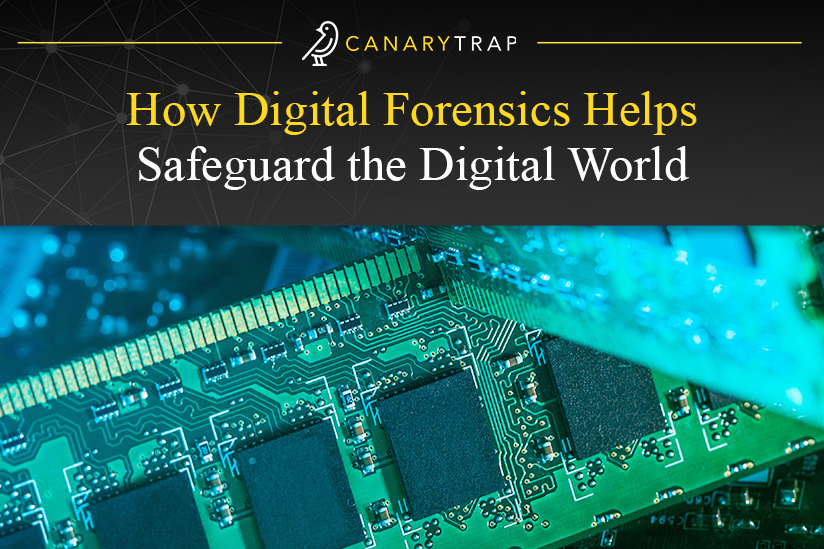How Digital Forensics Helps Safeguard the Digital World
- July 21, 2023
- Canary Trap
Living in a digitally driven world, it seems as almost every action we undertake leaves a digital footprint. From a simple text message to complex network transactions, we are constantly creating and interacting with digital data. But what happens when this data becomes part of a legal case, a corporate investigation, or a cybercrime incident? Here’s where the field of digital forensics comes into play.
With the advancement of technology, illegal activities and cybercrimes have also seen a surge. Traditional forensics is no longer sufficient to investigate these crimes. To combat the rising tide of digital crime and protect our data, we require specialized expertise that can navigate the intricate labyrinth of digital information, hence the increasing demand and importance of digital forensics.
What Is Digital Forensics?
Digital forensics, often referred to as computer forensics, is a specialized field that focuses on the recovery, investigation, and analysis of information found on digital devices. These devices can range from computers and smartphones to networks and cloud storage systems.
The information, referred to as digital evidence, can be utilized in legal proceedings, cybercrime investigations, or to assist in identifying and mitigating cybersecurity threats.
“Digital forensics includes recovering and preserving material found on digital devices during the course of a criminal investigation. The evidentiary nature of digital forensic science requires rigorous standards to stand up to cross examination in court”, add experts at Techopedia.
Digital forensics has grown into a vast field comprising various specialties, each focused on a particular type of device or data medium:
- Computer Forensics. This involves the examination of data found on computers and storage devices to gather evidence for legal proceedings or to detect malicious activity.
- Network Forensics. This field focuses on monitoring and analyzing network traffic, both local and internet, to detect security breaches or incidents.
- Mobile Forensics. This branch deals with the recovery of data from mobile devices, such as smartphones and tablets. With the widespread use of these devices, mobile forensics has become crucial in many investigations.
- Cloud Forensics. This field involves the investigation of data hosted on cloud services. As more businesses and individuals store data in the cloud, this area is of growing importance.
- Forensic Data Analysis. This specialty focuses on the inspection of large volumes of data to identify patterns, anomalies, and other relevant information.
It’s safe to say that each of these fields requires specialized knowledge and tools due to the distinct characteristics and complexities of the devices and networks involved.
Tools and Technologies Used in Digital Forensics
There are a plethora of tools that are used in digital forensics, each tailored for specific tasks. Here are some commonly used ones:
- Disk and Data Capture Tools. Software like FTK Imager and EnCase are used to create an exact copy of a drive without altering the original data.
- File Viewers. These are used to view or recover specific types of files. Tools such as the Hex Viewer can even allow investigators to view the binary data of a file.
- Registry Analysis Tools. Tools like RegRipper are used to analyze Windows Registry files, helping uncover valuable information about system interactions.
- Network Forensics Tools. Software like Wireshark allows investigators to capture and analyze network traffic, which can be invaluable in detecting and understanding cyber attacks.
- Mobile Forensics Tools. These are specifically designed to recover and analyze data from mobile devices. Examples include Cellebrite and Oxygen Forensics Suite.
- Cloud Forensics Tools. With an increasing amount of data stored on the cloud, tools like CloudForensics, that focus on retrieving and analyzing this data are crucial.
How Does the Digital Forensics Process Work
Digital Forensics follows a structured approach to ensure that all data collected can be used effectively, whether in a court of law or for an internal investigation. Here are the typical stages involved:
- Identification. The first step in the process is to identify the sources of digital evidence. These can range from computer systems, mobile devices, and network logs, to cloud storage platforms. The scope of the investigation will often determine what sources are relevant.
- Preservation. Once the potential sources of evidence are identified, steps must be taken to preserve the data. This is crucial as digital data can easily be altered or deleted, either intentionally or unintentionally. Investigators use specialized tools to create copies or images of the data, ensuring its original state is preserved.
- Extraction. In this stage, the preserved data is extracted for analysis. This could involve recovering deleted files, decrypting encrypted data, or even extracting data from damaged devices. The extraction must be performed carefully to avoid altering the data.
- Interpretation. This stage involves analyzing the extracted data to draw meaningful conclusions. It could involve identifying patterns, correlating data from different sources, or using the data to reconstruct potential scenarios.
- Documentation. Every step of the investigation must be meticulously documented. This includes documenting the procedures followed, evidence collected, tools used, and any changes made to the data. This documentation is vital, especially if it is to be used in court.
The Importance and Applications of Digital Forensics
In today’s world, digital forensics plays a crucial role in maintaining cyber resilience, supporting legal investigations, and ensuring a safe digital environment for individuals and organizations alike.
According to Interpol, “the main goal of digital forensics is to extract data from the electronic evidence, process it into actionable intelligence and present the findings for prosecution. All processes utilize sound forensic techniques to ensure the findings are admissible in court.”
Its applications span various industries, including:
Law Enforcement
- Criminal Investigations. Digital forensics plays a vital role in law enforcement investigations. In numerous criminal cases, ranging from cyberstalking and identity theft to more severe crimes like terrorism and murder, digital evidence can provide crucial leads or even solve the case. Investigators can uncover deleted emails, search history, or transaction records that may serve as evidence.
- Gathering and Preservation of Evidence. Apart from uncovering evidence, digital forensics also ensures the evidence is gathered and preserved in a way that maintains its integrity. This is essential as the court requires evidence to be handled and presented following strict protocols.
Corporate Environments
- Incident Response. In the corporate world, digital forensics is a critical part of incident response strategies. When a security breach occurs, digital forensics experts can help determine the extent of the breach, identify the culprit, and recover lost or damaged data.
- Fraud Detection. Companies also employ digital forensics for internal investigations, such as detecting fraud or other misconduct. By analyzing computer usage, email communications, transaction records, etc., digital forensics can reveal illegal activities.
Cybersecurity
- Threat Hunting. Digital forensics is used in proactive threat hunting, which involves identifying potential threats before they can cause damage. Through analysis of log files, network data, and system behaviors, experts can detect abnormal patterns that may indicate a cyber threat.
- Post-Breach Investigations. In the unfortunate event of a breach, digital forensics aids in post-breach investigations. It helps determine how the breach occurred, what vulnerabilities were exploited, what data was accessed or stolen, and aids in refining security measures to prevent future attacks.
Personal Privacy and Data Recovery
Digital forensics isn’t just for law enforcement and corporations. It can also help individuals protect their privacy and recover lost data. By understanding how data is stored, transmitted, and can be recovered, individuals can better protect their digital privacy and personal information.
In an investigation conducted by Science Direct, “there is a need for having privacy levels for computer forensics so that only relevant data are collected and then only private relevant data are encrypted.” By classifying and analyzing all data access possibilities, privacy levels for digital forensics can be defined to provide a more effective solution.
Emerging Trends and Technologies in the Field
As technology continues to evolve, so does the field of digital forensics. Here are some of the trends and advancements expected to shape the future of digital forensics:
- AI and Machine Learning. As the volume of digital data continues to grow, AI and machine learning will play a pivotal role in quickly and accurately analyzing this data. These technologies can help automate data analysis, uncover patterns, and detect anomalies more efficiently.
- Cloud Forensics. With more individuals and businesses shifting to cloud-based solutions, cloud forensics will become increasingly important. Developing effective methods for investigating cloud-based crimes and retrieving data from the cloud will be a major focus area.
- IoT Forensics. The proliferation of Internet of Things (IoT) devices, from smart homes to wearable technology, presents a new frontier for digital forensics. These devices generate a vast amount of data, creating new opportunities and challenges for investigations.
- Live Forensics. Traditional digital forensics often deals with static data, but there’s a growing interest in live forensics, which involves analyzing data in real-time, while the system is running. This approach could provide additional insights into ongoing cyber-attacks.
What Are the Challenges of Digital Forensics?
The future of digital forensics also comes with potential challenges, including:
- Encryption. While encryption is vital for securing data, it also presents a significant hurdle for digital forensics, as it can prevent investigators from accessing needed information. New tools and techniques will need to be developed to overcome this challenge.
- Privacy Concerns. Balancing digital investigations with respect for privacy will continue to be a major concern. Ensuring transparent, ethical practices will be essential in maintaining public trust.
- Technical Advancements. The rapid pace of technological innovation means that digital forensics must continually adapt. Keeping up with new devices, technologies, and cybercrime tactics requires continuous learning and advancement in the field.
Addressing these challenges will be crucial for the future of digital forensics. According to an article published by Intellipaat, “to overcome the challenges, Digital Forensics professionals need to invest in the required tools and resources, stay up to date on technical advancements, and work closely with the legal and investigation communities to establish standards and guidelines.”
However, with ongoing research and the development of new methodologies and technologies, the field is well poised to continue evolving alongside the digital world it investigates.
In Conclusion
In our increasingly digital world, the importance of digital forensics cannot be overstated. As we continue to produce vast amounts of data and rely heavily on digital technologies for various aspects of our lives, the role of digital forensics in maintaining digital security, ensuring justice, and mitigating cyber threats becomes more critical than ever. Whether it’s helping to solve crimes, protecting corporate interests, or safeguarding personal privacy, digital forensics has a significant impact.
The field of digital forensics is vast, dynamic, and ever evolving. As we continue to advance technologically, the need for professionals skilled in this field will only grow. For those considering a career in this area or just looking to enhance their understanding, continuing to stay informed and educated about the latest trends and developments in digital forensics is invaluable. As we move forward in this digital age, we do so with the knowledge that digital forensics serves as a key guardian of our digital world.
SOURCES:
- https://www.techopedia.com/definition/27805/digital-forensics
- https://www.interpol.int/en/How-we-work/Innovation/Digital-forensics
- https://www.sciencedirect.com/science/article/pii/S1877050915017032
- https://intellipaat.com/blog/digital-forensics/?US#:~:text=Digital%20Forensics%20requires%20a%20high,through%20and%20identify%20relevant%20evidence.

